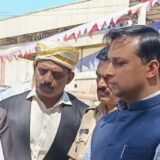
By P.T. Bopanna
Kodavas (Coorgs) living in Karnataka have only two main festivals. However, of late, the community has lost enthusiasm in celebrating both these festivals.
Instead, due to the influence of Hindutva, the community is more enthusiastic now in celebrating Kaveri Sankramana, a festival which was imposed on the Kodavas by Lingayat Rajas who ruled Kodagu. The Kaveri festival is more influenced by Brahminism and is not in consonance with the culture of the Kodavas.
The two main festivals of the Kodavas are Kailpolud, the worshipping of arms; and Puthari, the harvest festival. Both festivals are related to paddy cultivation cycles and have nothing to do with any god.
Being nature worshippers, Kodavas had venerated the life-sustaining river Cauvery which originated in their land at Talacauvery. Till Kodagu was annexed by Lingayat Rajas around 1600, Kodavas customarily collected water from Cauvery in the month of October from the upper reaches of the river when the water was in its purest form and used the water for their rituals.
The Lingayat Rajas who took over Kodagu, built Hindu temples and brought Brahmin priests from outside and appointed Kodavas as Deva Thakkas, administrators of temples.
And over time, the Brahmin priests fabricated ‘Kaveri Purana’ and weaved a mythological story that Agastya’s wife Kaveri turned into a river to serve mankind.
In his article published in the book ‘Are Kodavas (Coorg) Hindus?’, Major General Codanda K. Karumbaya, noted: “However interesting and convincing the mythological story may be, it directly impinges on the Kodava belief in Nature. This river, Nature’s creation, has existed for centuries, long before Agastya or the Kodavas set foot in Kodagu. Without this river, how could the copious monsoon water which the land received, drain out of Kodagu?
“Kodavas must believe in truth and not continue to be fooled. The so-called ‘Theerthodbhava’ (annual re-birth of the river), cannot be true, as any geologist with basic knowledge can testify. It is ridiculous to claim that the river’s water erupts once a year at the Kundike, the pond from where the river Cauvery takes birth, precisely on the date and at the time predicted by Hindu priests.
“During the month of October in Kodagu, it is usual for bubbles to pop up in water bodies like the Kundike due to the release of air pockets in the underground vents through which the spring water emerges. Such phenomena are seen in many parts of the world. That some Kodavas still believe in Theerthodbhava, sadly exposes our submissive acceptance of what the Hindu priests tell us and our lack of scientific temper. We should worship Kaveri water in its natural form and not in a human form, that too in an alien dress. We need to restore our faith in what is true rather than placing our trust in mythological stories, written with ulterior motives.”
The General wrote in the book, “Kodavas must get over their inferiority complex brought about by years of political and cultural subjugation. Recognizing the merits of our own religion is one of the steps to restore our confidence in ourselves.”
Though Kodava festival of Puthari and Kailpolud have special culinary fare to mark the festival, the food served for Kaveri Sankramana is not indigenous to Kodagu.
“Thambuttu and Puthari Kalanji (a kind of yam available around harvest time) are special for Puthari, while Kadambuttu and Pandi curry are a must for Keilpolud, the festival of weapons. At Kaveri Sankramana, a festival influenced by Brahmins, the special dishes are all vegetarian and not indigenous to Coorg – dosa and pumpkin curry, for example”.
There is another important reason why the Kaveri festival has gained traction. On the occasion of Theerthodbava, Kodavas have begun marching in large numbers in their traditional dress. Earlier, the BJP leaders were more visible on such occasions. Now the social media is full of videos posted by a Congress leader.
There are reasons why Kodava festivals lost their significance. Puthari, the harvest festival lost its sanctity after people stopped cultivating paddy, as paddy harvest was central to the festival.
Kodavas living in cities have abandoned the Kailpolud, a festival dedicated to merry-making by consuming pork and hard liquour. Kodava women who have been imitating Brahminical festivals, have stopped cooking non-veg dishes during Kailpolud as the Ganesha festival also falls around the same time.
Thankfully, many Kodava youngsters have realized their folly in abandoning Kodava festivals.
This year many Kodavas held ‘Bhale Namme’, festival to mark the transplantation of paddy and held sporting event like slush race to attract people.
The developments in Kodagu reminds me of the lines from Irish poet Oliver Goldsmith who wrote “where wealth accumulates, men decay”.
I am writing this article in the run-up to the publication of my forthcoming book “Kodava Religion at Crossroads” which deals with how Kodavame or Kodava way of life is vanishing similar to how the numbers of Kodavas are dwindling.
























